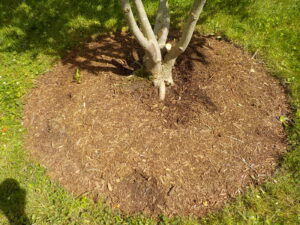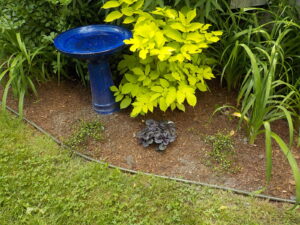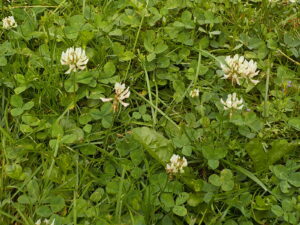The Battle between the Mower and the Grower
Posted on Tuesday, July 5, 2022 · Leave a Comment
In most households, one person is the gardener, and another takes care of the lawn. Or perhaps a hired service or teenager does the mowing and string trimming. But it is common that there is conflict between the two parties. There are ways to minimize the problems if both parties are willing to compromise – and perhaps do a little extra work.
The mower generally wants to get the job done quickly. There are other things to do in summer – other lawns to mow, ponds to swim in, or hammocks to doze in. What can the gardener do to help the mower?

Keep mulch from touching the tree. This ring will keep mowers and trimmers away from the trunk.
First, create a nice mulch ring around trees and shrubs. This will accomplish a couple of things: it will protect the bark of a tree from damage by a string trimmer. And it will hold in moisture and keep down weeds, benefiting the tree. For the mower, it will speed up the process of mowing round the tree and may even obviate the need to use the string trimmer. But never let the mulch touch the tree – it can cause it to rot, eventually killing it.
What else can the gardener do to help the mower? Remove low hanging branches. Apple trees, among others, often have low branches that reach out way beyond the circumference of the mulch ring. And yes, it is nice to be able to pick apples of those low branches, but do you really need them at the three or five-foot level?
Quite frankly, I think trees look better if the lower branches are removed and the bark of the trunk is on display. Many trees have nice looking trunks with interesting bark. I like to see the “legs” of a shrub or tree.
And what can the mower do to help the gardener? Blow the grass away from the flower or vegetable beds. There are few things more annoying than weeding and mulching a flower bed, only to have a person with a mower blow grass and perhaps dandelion seeds into the bed. And yes, I have seen professionals then blow the grass off the bed, but it is so much easier (and quieter) to just point the mower so that it blows the grass away from the beds.

Keep hoses off the lawn where you can
Then there is the issue of hoses. Mowers generally do not want to be bothered disconnecting hoses that cross the lawn. They say that a mower with blades set at three inches should clear the hose, running right over it safely. But sometimes the front wheels of the mower will somehow push the hose up. And then the hose can be damaged.
So what can you do? If you are depending on a hose for regular watering of new trees or perennials, you probably need the hose to cross the lawn so it can be used every day or two. Think about burying the hose. If you are crossing a section of lawn that is heavily traveled, you may wish to dig a six-inch deep trench and slide the hose inside a section of plastic pipe.
To avoid having to re-seed the trench, use an edging tool to slice through the grass and lift strips if sod out carefully and set them aside. Dig a shallow trench and after pushing the hose through the pipe and placing it in the ground, cover the pipe with some good top soil. Then take the sod and fit it back where it was before.
The advantage of the pipe system is that you can pull the hose out of the pipe if it develops a leak, or if you want to put it in the barn for the winter. Quite frankly, I don’t think you need to bother with a pipe – or even burying it completely. Just take your edging tool or a straight-bladed shovel and slice into the lawn. Pull the handle back and forth, creating a “V” in the grass. Push the hose into the “V” and step on it. Push hard enough so that the top of the hose is not sticking up into the grass, but is right on the soil line. As the grass grows, you will not see the hose. I have done this, and left hoses in the ground for years with no ill effects.
People who mow, generally, also like to string trim the edges of beds and around trees. A common mistake is to trim the edges too close to the ground, “scalping” the grass near the flower beds. I have no suggestions on how to avoid this, except to politely ask the mower NOT to trim so darn close. Maybe growl a little.

Clover in the lawn is good for bees and pollinators
Then there is the question of how often to mow. People who mow commercially like to have a regular schedule, and as often as possible. But if your spouse or child is the mower, point out to them that you want to let the grass get a little taller before mowing. Explain that the Dutch white clover that only blooms when the lawn is a little long is much loved the bees and pollinators. Get them to think of the lawn as the lunch buffet for bees.
If you set the mower at three or four inches, your lawn will thank you. Yes, I know that the infield of Fenway Park is cut at less than an inch, but your half acre of lawn need not be. Grass plants need to feed their roots so they can grow deep into the soil – where the moisture is in dry times. The longer each blade of grass, the more food it can make by the miracle of photosynthesis.
If you keep your lawn longer, it will compete better with crabgrass and weeds. And you will get used to seeing it longer, and like it – or at least I do. You should not think it is a sign of indolence to have a lawn that doesn’t look like a green buzz cut.





